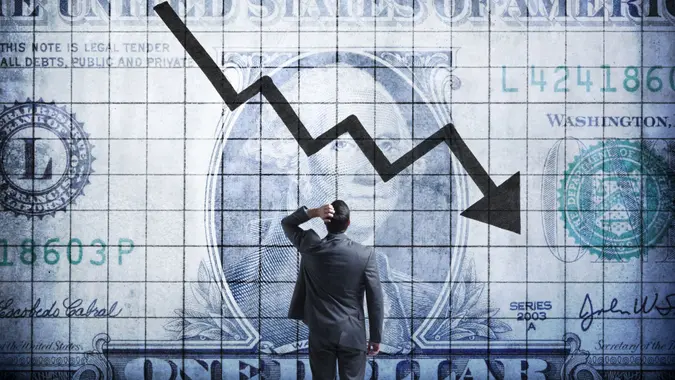We’re Spending Way Less Than We Were a Year Ago — And Credit Card Companies Are Reaping the Benefits

Commitment to Our Readers
GOBankingRates' editorial team is committed to bringing you unbiased reviews and information. We use data-driven methodologies to evaluate financial products and services - our reviews and ratings are not influenced by advertisers. You can read more about our editorial guidelines and our products and services review methodology.

20 Years
Helping You Live Richer

Reviewed
by Experts

Trusted by
Millions of Readers
Consumer spending is slowing down, but this isn’t worrying investors at credit card companies.
Several credit card companies cited signs of slowing growth in consumer spending in their most recent earnings reports — however, credit card company stocks are still outperforming those of banks in 2023. An index of consumer finance companies in the S&P 500 is up almost 6%, versus a more than 10% decline for S&P 500 banks, The Wall Street Journal reported.
Credit card companies typically earn more in fees when consumers spend and more in interest when they carry a balance, but the WSJ noted that one important metric isn’t worrying investors — credit risk. Consumers have cut down on spending, which means they aren’t overextending themselves during times of economic uncertainty.
Consumers remained resilient throughout much of the pandemic, but retail sales have dipped over the last several months. Consumers are beginning to put off big-ticket purchases, analysts told ABC News, and this pushback could continue if prices don’t come down.
“Consumers are generally starting to slow spending and become a bit price sensitive,” Randy Konik, a retail analyst at financial services firm Jefferies, told ABC News. “Inflation is going to keep putting pressure on consumer wallets.”
According to the WSJ, some credit card companies built reserves against potential loan losses during the first quarter. This means that newer credit card balances risk not being paid off.
WSJ pointed out credit risk measures like 30-plus-day-delinquency rates are rising, but are normalizing to levels seen before the pandemic. This could mean a change in the macro forecast may allow some lenders to release reserves and boost earnings.
 Written by
Written by  Edited by
Edited by 

























